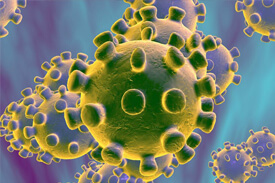 31 Mar, 2020
31 Mar, 2020
Severe Acute Respiratory Syndrome Coronavirus 2 (SARS-CoV-2, formerly known as 2019-nCoV), the causative pathogen of Coronavirus Disease 2019 (COVID-19) has rapidly spread across China and other parts of world, causing pandemic situation. There are no specific antiviral therapies or vaccines available. Hence treatment strategy for Covid-19 infection is supportive including antivirals, broad spectrum antibiotics, corticosteroids and plasma.China has used both conventional and traditional Chinese medicine for the treatment of SARS-COV-2 infected patients.
COMMONLY USED DRUGS
1. Lopinavir/ritonavir
Lopinavir/ritonavir is a protease inhibitor which is widely used for treating HIV infection.Its antiviral action has been demonstrated against SARS in different studies.
Mechanism of Action: Lopinavir inhibits viral replication. Ritonavir enhances plasma levels of lopinavir. It reduces SARSCoV2 replication.
Dosage:
Adults: The recommended dose for COVID-19 is the 400/100 mg twice daily (the standard dose used for HIV therapy). If there is difficulty in swallowing, oral solution should be administered(tablets cannot be crushed)
Children: Less than 15 kg: 12 mg/kg/dose (lopinavir component) orally twice a day
- 15 to 40 kg: 10 mg/kg/dose (lopinavir component) orally twice a day
- Greater than 40 kg/ dose: Lopinavir/ ritonavir 2x200/50 mg tablet, orally twice a day
It should not be administered to neonates before gestational age of 42 weeks and postnatal age of at least 14 days.
Adverse Effects: QT prolongation, Torsade de Pointes, pancytopenia, pancreatitis, hepatotoxicity,Hypersensitivity reaction, angioedema, nausea,In the light of the possible shortage of lopinavir/ritonavir stocks due to the increasing prescriptions, alternatives include
a. Darunavir/ritonavir: 600 mg twice a day also has similar action and optimal safety.
b. Remdesivir (GS-5734):It is a new nucleotide analogue which has shown good activity against other coronavirus like SARS, MERS. Mechanism of Action: It inhibits viral polymerase.
2. Tocilizumab: It is an anti-human IL-6 receptor monoclonal antibody.
It can be used in severe COVID-19 patientslike those with respiratory symptoms unstable but not critical, with mild to moderate dyspnoea, tachypnea, in moderate ARDS.
Dosage: 8 mg/kg intravenously (maximum 800 mg/dose) infused over an hour. Additional administrations are based on patient’s response. It is advisable to monitor complete blood count, AST/ALT, C-reactive protein while on treatment
Adverse events: Severe life-threatening infections, hepatitis
Caution: needed in pregnancy, breast feeding, active/latent tuberculosis, on chemotherapy.
3. Chloroquine and hydroxychloroquine
Chloroquine is widely used as anti-malarial drug and used as anti-inflammatory drug for rheumatologic diseases. Several studies have shown its efficacy against SARS and influenza.Hydroxychloroquine, is an analogue of chloroquine and has similar effect on SARS-Cov-2
Mechanism of Action It is suggested that chloroquine changes cell membrane pH, necessary for viral fusion and glycosylation of viral proteins.
The National task force for COVID 19 recommends the use of hydroxychloroquine for prophylaxis of SARS-COV-2 infection for selected individuals as follows:
1. Asymptomatic healthcare workers involved in the care of suspected or confirmed COVID-19 patients.
Dose: 400 mg twice daily on day1, followed by 400mg once a week for next seven weeks
2. Asymptomatic household contacts of confirmed cases.
Dose: 400 mg twice daily on day1, followed by 400mg once a week for next three weeks.
Contraindications:
1. Not recommended for prophylaxis in children less than 15 years.
2. In persons with known hypersensitivity to hydroxychloroquine, retinopathy
Dosage of chloroquine
Adults: Chloroquine 500 mg bid for 10 days in combination with another antiviral agent (Lopinavir/ritonavir or Remdesivir). Hydroxychloroquine 400mg/day in 2 divided doses for 5-14 days.
Children:
<6 years: Hydroxychloroquine 6.5mg/kg/day BD (max 400mg/day)
> 6 years: Hydroxychloroquine 10mg/kg/day BD (max 400mg/day)
Adverse Effects: QT prolongation & torsades de pointes, pancytopenia, anaphylaxis reactions, hepatitis, reduction in seizure threshold, nausea/ vomiting, diarrhea, abdominal pain,headache.It is important to check G6PDH prior to starting treatment.
Contraindications: Porphyria, G6PD deficiency, heart disease,epilepsy.
Traditional Chinese Medicine
Along with the conventional therapies, SARS-CoV-2 infected patients in China are also receiving Traditional Chinese Medicine (TCM) treatment. TCM was largely applied during the outbreak of SARS as TCM herbal extracts has capacity to inhibit enzyme activity of SARS.Chinese Rhubarb extracts, extracts of Houttuynia cordata (fish leaf/chameleon plant),extracts from litchi seeds,extracts from the root of Isatis indigotica (dyer’s wood) have shown beneficial effects. Herbs derived from sinigrin(brassicaceae), indigo, aloe-emodin, hesperetin(citrus fruits), quercetin, epigallocatechin gallate (found in tea) were found to inhibit SARS activity. Herbacetin(flaxseed), isobavaschalcone(psoralea corylifolia), quercetin, and helichrysetin(sunflower family) had the potential to block the enzymatic activity of MERS protease.Extracts of Kang Du Bu Fei Tang,Sinomenium acutum, Coriolus versicolor and Ganoderma lucidum inhibited SARS enzyme activity.
REFERENCES
1. Yang Y, Islam MS, Wang J, Li Y, Che X.Traditional Chinese Medicine in the Treatment of Patients Infected with 2019-New Coronavirus (SARS-CoV-2): A Review and Perspective. Int. J. Biol. Sci. 2020; 16(10): 1708-171.
2. Nicastri E, Petrosillon N, Bartoli TA, et al. National Institute for the Infectious Diseases “L. Spallanzani, IRCCS. Recommendations for COVID-19 clinical management. Infect Dis Rep.2020;12(1):8543.
3. www.mohfw.gov.in
|